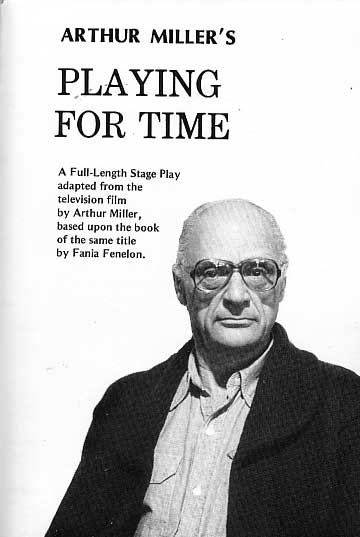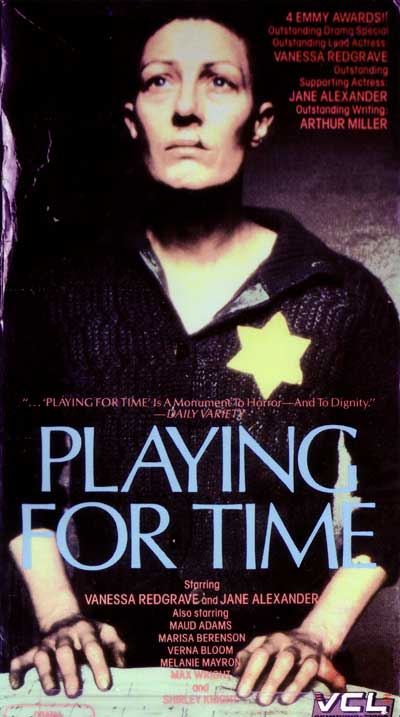 hi
hi 
PLAYING FOR TIME
A Full-Length Stage Play
adapted from the television film
by Arthur Miller,
based upon the book
of the same title
by Fania Fenelon
Rights: The Dramatic Publishing Company
P.O. Box 129
Woodstock, Illinois 60098
“Playing For Time” is about a group of female musicians who saved their lives by playing in an orchestra at Auschwitz for Dr. Mengele and the SS. Patients in the hospital were soothed with Beethoven, and a marching band played for incoming prisoners before many were escorted to crematoriums. As an actor, a musician, an artist, a female, a mother, an American and a non-Jew, this movie for television forced me to witness aspects of human nature that I did not want to see. Such experiences caused Eli Weisel to write, “Indifference, then, is not only a sin, it is a punishment.” Arthur Miller wrote the teleplay and adapted it for the stage. Vanessa Redgrave deservedly won the best actress Emmy for her portrayal of Fania Fenelon, a Jewish Cabaret singer in Paris, who suddenly found herself bound to uplift the spirits of mass murderers. Jane Alexander won an Emmy for her portrayal of the strict conductor and violinist, Alma Rose, Gustav Mahler’s niece. Alma had so much pride and artistic integrity that she refused to look at whom she was creating for. As Alma says, “You seem to think I fail to see…I refuse to see.” By refusing to see, however, she became not dissimilar to the character portrayed by Alec Guiness in “The Bridge On The River Quai,” an artist incapable of distinction.
“Miller cites the Holocaust as the period when the world learned to turn away, and feels that this is the problem, which persists in society, whenever atrocities occur, from Bosnia to Africa to South America. He insists that we combat this tendency to ignore what is unpleasant in life and involve ourselves before another Holocaust can occur (Abbotson 13).
The cast includes thirty-eight actors and musicians, made up of eighteen women, four men and approximately sixteen extras (both male and female), to play the smaller speaking roles. Ten of the actors must be fair to excellent musicians. Twelve excellent musicians are needed for the orchestra, which consists of four violinists, an accordionist, a percussionist, a mandolinist, a flutist, a female and a male cellist, a cymbalist and a guitarist. With the exception of the barracks, which can be built as a series of shelves, the rest of the set is indicated by light cues. No real set is needed. Alma’s room is an open space with a cot and a chair, the boxcar is an open space, it’s crowdedness created by the acting and a confined, rectangular light. The rehearsal room is also an open space with music stands and a piano, but it should have a single hanging window that looks out onto the camp. The window is an important symbolic element of the play. We become aware of who chooses to look through the window and “see.”
Most prisoners had their hair shaven upon arrival at Auschwitz, but neither Alma, as conductor, nor the Poles in the orchestra were shorn. For other characters, the script suggests that heads could be covered with dull colored bandanas over skullcaps.
The music in this play is snippets of some of the most exquisite ever written. Composers are Bach, Beethoven, Brahms, Mozart, Mendelssohn, Mahler and Wagner. PLAYING FOR TIME also includes songs with lyrics in Italian, French, and German. The actress playing Fania Fenelon must be able to sing Puccini’s “Un Bel Di” and Gershwin’s “That Man of Mine” equally well. She also has to play the piano. Since the character is from France, she can have an Edith Piaf kind of voice (as Vanessa Redgrave did) or a more trained operatic sound. The character of Alma must be able to play the violin exquisitely.
Since the set is minimal, there should be a constant soundscape to suggest the surroundings. Sounds such as attack dogs barking, whistles blowing, machine guns, shovels digging, trucks, and trains arriving should variously be audible. At the climax of the piece, sounds are needed of bombs exploded by Russian and German artillery. Lights are crucial for establishing different rooms and setting the tone. Spotlights flash by the window at night. Sometimes they are accompanied by a single shot.
“The
film raises several questions about courage, guilt and survival at any price,
but the most controversial aspect was the casting of anti-Zionist Vanessa Redgrave as
Fania Fenelon. Like many others, the real-life Fenelon (who died in 1988) was
vehemently opposed to Redgrave's appearance
in the film.”
By Hal
Erickson, All Movie Guide
Vanessa Redgrave was despised for
doing this part. She received hate mail, even though her work was flawless and
her commitment total. Apparently, many people missed one of the main points of
the play and dehumanized the actress because of her religious beliefs.
As opposed to the graphic nature of
the television depiction, the play is available to a broader audience, because
the horror is reinforced by the imagination rather than the arresting physical
elements in the film. PLAYING FOR TIME is particularly appropriate for a high
school that supports the arts. It presents the opportunity to form a union of
artists in a cooperative effort of many elements, which will become an
empathetic symphony of its own. It affords a rare opportunity to open young
people to an arcane, sophisticated world of inexplicable human conflict and
suffering.
Works
Cited
Abbotson, Susan. “Student Companion to Arthur Miller.”
Greenwood Press, 2000